DACF Home → Bureaus & Programs → Maine Natural Areas Program → Communities, Plants, and Animals → Invasive Plants → Black Swallowwort
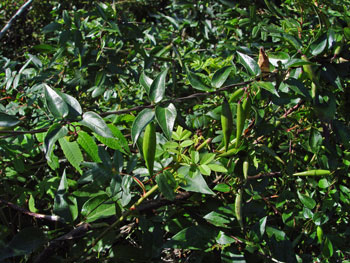 Black swallowwort
Black swallowwort
Black Swallowwort
(Dog-strangling vine)
Cynanchum louiseae
2019 Status in Maine: Localized. Severely Invasive.
Description: Perennial, herbaceous, thin, twining vine commonly up to 6' in length. Leaves: Opposite, lance to heart shaped, broad at base and tapered to point, 2½-5" long, up to 3" wide, turn yellow in fall. Flowers: 5-pointed star-shaped, dark purple-brown , ¼" diameter. Appear in loose cymes of 6-10 flowers in leaf axils, May-September Fly pollinated, nectar smells like rotting fruit. Fruit: Slender, 1-3" long, green pods release brown seeds with white silken parachutes, similar to milkweed, that catch the wind. Seeds are polyembryonic, which means one seed can produce multiple seedlings. Germination rate is 30-50%. Seed longevity is not known. Stems: Covered in fine, downy hairs. Roots: Extensive rhizomatous root systems. Note: Leaves and roots are toxicto Monarch butterfly larvae. Research indicates that swallowwort roots can change soil conditions through allelopathic extracts and amplified associations with generalist mycorrhizal fungi, which can reduce native plant diversity.
Native range: Europe. How arrived in U.S.: As an ornamental.
Reproduction: By seed and vegetatively by trailing stoloniferous stems and rhizomes. Seeds are windblown or can be carried on animal fur or perhaps in soil.
Habitat: Prefers enriched soils and sun but can establish dense stands under a wide range of conditions including old fields, roadsides, woodlands, and well-drained uplands.
Similar native species: No native vines of similar character. Dogbanes (Apocynum spp.) may superficially look similar, but are perennial, upright herbs of open areas, with leaves tapering to the base.
Similar non-native species: Pale swallowwort (Cynanchum rossicum) is also invasive and is very similar; its flowers are light pink-gray-purple rather than the dark purple of black swallowwort. Pale swallowwort is very uncommon in Maine. Treatment methods are the same for boths pecies.
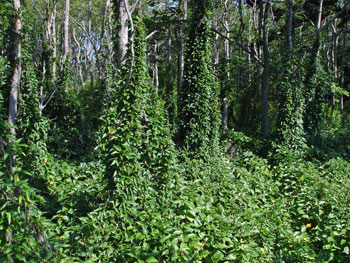 Black swallowwort infestation
Black swallowwort infestation
Documented Ecological Impacts
- Black swallowwort can form large patches that crowd out native vegetation and alter the physical structure of habitats. (Plant Conservation Alliance Black Swallow-wort Fact Sheet, Invasives.org 2020)
- The changes in structure and insect communities in old fields has potential to reduce nesting and foraging sites for native birds, causing a decline in grassland bird presence. (Plant Conservation Alliance Black Swallow-wort Fact Sheet, Invasives.org 2020)
- Black swallowwort can be a population sink for Monarch butterflies and may outcompete the Monarch’s preferred host, common milkweed. (Stone, Katharine R. 2009. Cynanchum louiseae, C. rossicum. In: Fire Effects Information System. U.S. Department of Agriculture, Forest Service)
Fact Sheets and Identification Links
- Vermont Fact Sheet for Black Swallowwort
- University of Wisconsin (2:50), Identification video
- Go Botany page for Cynanchum louiseae
- Michigan DNR Best Control Practices Black and Pale Swallow-worts
- NH Department of Agriculture, Markets & Food Black and Pale Swallow-wort Control Guidelines
Control Methods
Dig root crowns before seed pods develop. Be sure to remove all roots and dispose in garbage*. This is effective in small populations. Mowing encourages vigorous re-sprouting, but multiple mowings before pod production will prevent seed production. Foliar spray of triclopyr† before flowering stage (but not too early, plants need to have enough surface area to absorb lethal dose of herbicide), or glyphosate after flowering is initiated is effective. Follow-up spraying will be needed since the dense leaves keep herbicide from reaching enough of the plant for complete control in one application. Small plants regenerating after treatment blend in well with other vegetation - careful scrutiny is needed for detection and further treatment. Some people have skin reactions to this plant; wear gloves.
* Correctly dispose of all plant parts↵ † Follow all label directions when using herbicides↵Control Technique Video Demonstrations
Please email invasives.mnap@maine.gov if you have questions about invasive species in Maine
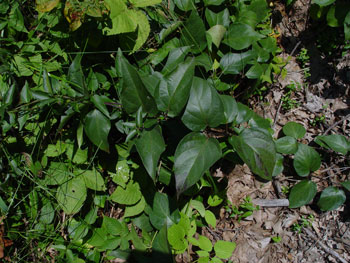 Black swallowwort leaves
Black swallowwort leaves
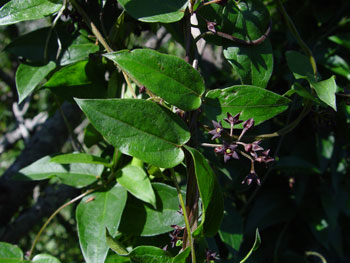 Black swallowwort
Black swallowwort
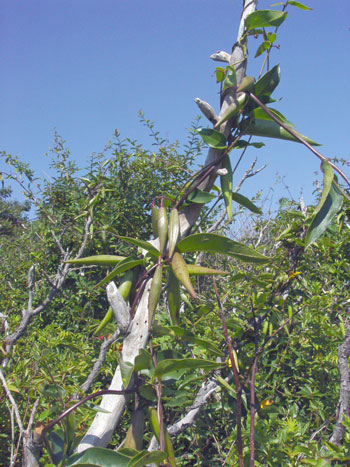 Black swallowwort
Black swallowwort
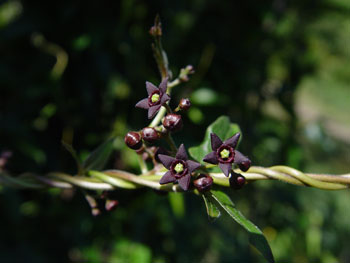 Black swallowwort flowers
Black swallowwort flowers